|
The important pest and diseases of bhindi, their symptom and control measures are
as detailed below.
Pests
Shoot and fruit borer (Earias vittela
and E. insulana)
Small brown caterpillars bore into the top shoot and feeds inside the shoot before
fruit formation. Later on they bore into the fruits and feed within. Affected fruits
become unfit for consumption. The fruit borer incidence is severe in humid conditions
especially after the rainfall.
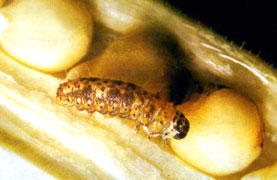
Control: All the infested fruits
and shoots should be removed regularly and buried deep in the soil. Spray carbaryl
@ 0.15% or neem oil emulsion @ 5%, at intervals of 15 to 20 days. Spraying with
quinalphos 25 EC (2 ml/litre of water) or carbaryl (4 g/litre of water) also effectively
controls the pest. Before spraying all the affected plant parts should be removed.
Root knot nematode (Meloidogyne incognita)
The root knot nematode enters the roots causing characteristic root knots or galls.
The aerial symptoms consist mainly of stunted plant growth and yellowing of leaves.
Nematode attack in the seedling stage leads to pre and post emergent damage resulting
in reduced crop stand.
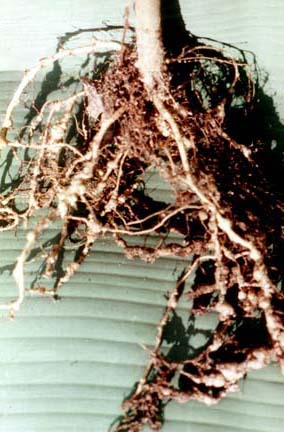
Control: Apply sawdust or paddy
husk at 500 g/plant or neem leaves or Eupatorium leaves at 250 g/plant
in basins one week prior to planting and water daily. The effect of this treatment
persists up to 75 days after sowing in summer season. Cultural control methods such
as rotation with non host crops like cereals; fallowing; deep ploughing 2-3 times
in summer months, etc. greatly reduce nematode population in soil. Application of
nemagon (30 litres/ha) with irrigation before sowing protects the seedling in its
early stage of growth. Application of Bacillus macerans or B. circulans
(1.2 x 106 cells per pit) before sowing is recommended for the control
of root knot nematode.
Leaf hopper (Amrasca biguttula biguttula)
Nymphs and adults of a small, greenish leafhopper suck plant sap from the undersurface
leaves and as a result the leaves curl upwards along the margins and have a burnt
look, which extend over the entire leaf area giving the typical ‘hopper burn’
symptom. The affected plants show a stunted growth. This pest attack is serious
in early stage of the crop.
Control: 4-5 foliar sprays
of dimethoate (0.05%) at an interval of 10 days effectively controls the pest.
Mites (Tetranychus spp.)
Nymphs and adults of mites suck cell sap and whitish grey patches appear on leaves.
Affected leaves become mottled, turn brown and fall. The infestation of mites is
mostly observed during the warm and dry periods of the season.
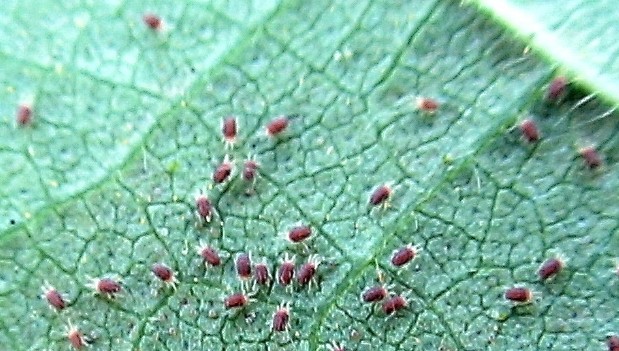
Control: Spraying with wettable
sulphur 80 WP (2 g/ litre of water) or dicofol 18.5 EC (2.5 ml/litre of water) effectively
control the mites.
White fly (Bemisia tabaci)
Nymphs and adults of a milky white minute fly suck the cell sap from the leaves.
The affected leaves curl and dry. Affected plants show a stunted growth. White flies
are the natural vectors of yellow vein mosaic virus (YMVY) and hence controlling
this pest provides protection against the virus infection also.
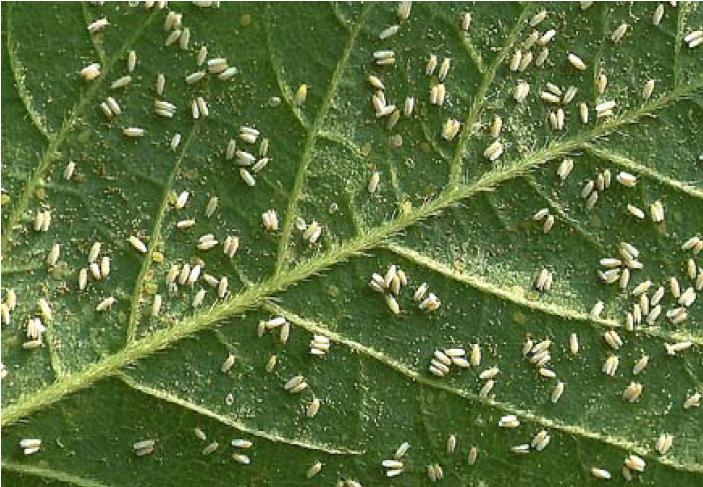
|
|
|
Whiteflies
|
Adult and eggs of whitefly
|
Control: 4-5 foliar sprays of dimethoate
(0.05%) at an interval of 10 days effectively controls the whitefly population.
Aphids (Aphis gossypi)
Aphids in large number congregate on tender parts of plant and suck
sap resulting in curling and crinkling of leaves. Ants carry aphids from one plant
to another.
Control: Need based application
of insecticides like dimethoate 0.05%. has been recommended. Application of tobacco
decoction also controls the pest effectively.
Diseases
Yellow vein mosaic (Yellow Vein
Mosaic Virus)
This is the most important and destructive viral disease in bhindi characterized
by vein clearing and chlorosis of leaves. The yellow network of veins is very conspicuous
and veins and veinlets are thickened. At times, enations or raised structures are
observed on the under surface of infected leaf. Growth of plants infected in the
early stages remain stunted. Fruits of the infected plants exhibit pale yellow colouration;
and are small and deformed with tough texture. The disease infects at all the stages
of crop growth and severely reduces growth and yield. Hence, their control is very
important. White fly (Bemisia tabaci) and leaf hopper (Amrasca biguttula
biguttula) are vectors of this virus.
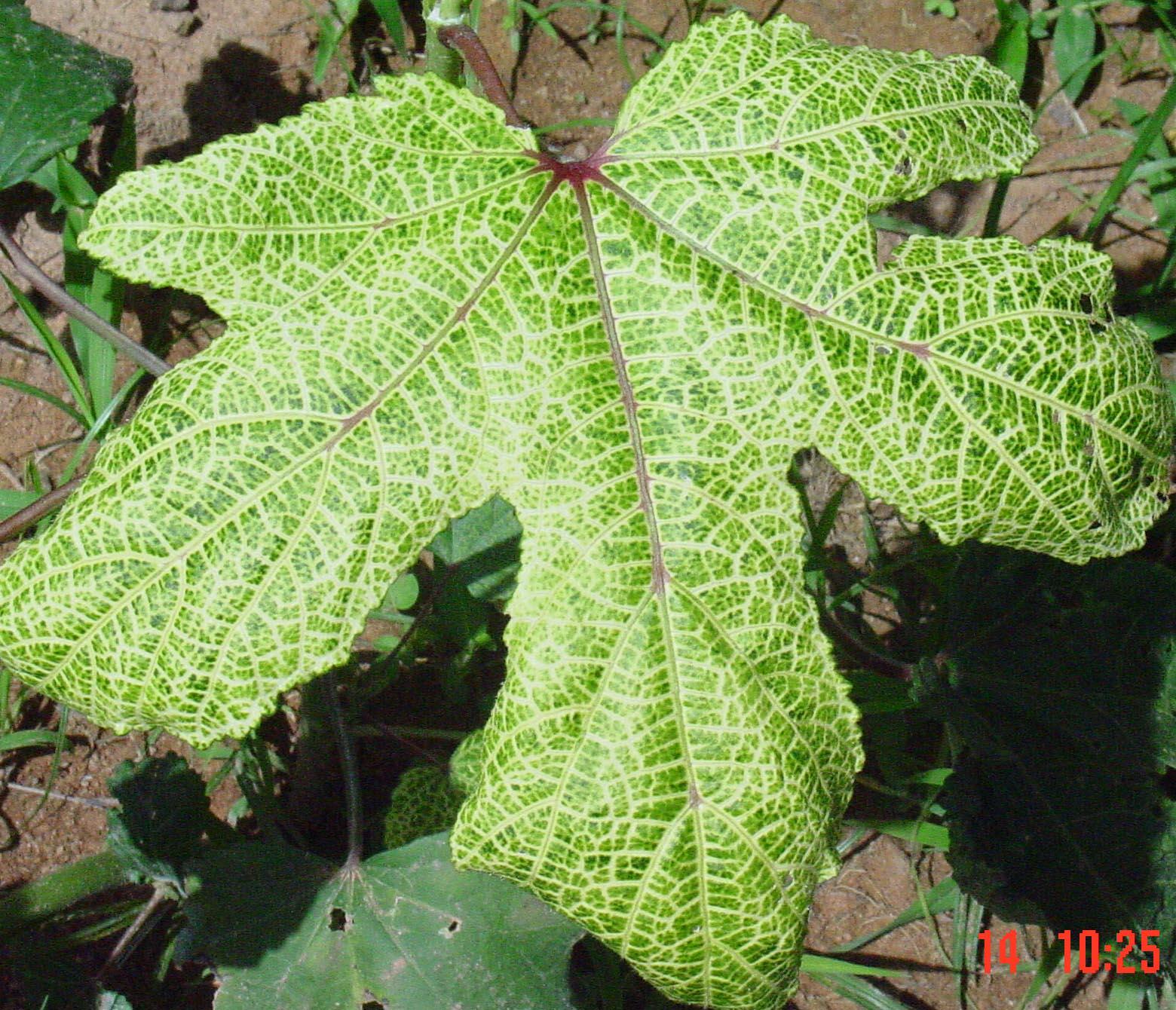
Control: Clean cultivation practices,
removal and destruction of virus affected plants and planting disease resistant
varieties reduces the disease incidence. Controlling the whitefly population minimizes
the incidence of YVMV. 4-5 foliar sprays of dimethoate (0.05%) or neem oil emulsion
(5%) at an interval of 10 days effectively controls the whitefly population. Use
of resistant varieties like Arka Anamika, Arka Abhay and Susthira, and destruction
of host weeds like Croton sparsiflora and Ageratum sp. are also effective.
Damping off (Pythium sp., Rhizoctonia
sp.)
Causes death of seedlings before or soon after emergence. Pre emergence infection
results in poor germination, whereas in post emergence infection, the emerged seedlings
develop a lesion at collar region. The tissues beneath the lesion become soft due
to which the seedlings die and collapse which is referred to as "damp off". Cool,
cloudy weather, high humidity, wet and compacted soils, and overcrowding favour
development of damping off.
Control: Excessive irrigation should
be avoided to reduce humidity around the plants. Seed treatment with antagonist
fungal culture of Trichoderma viride (3-4 g/kg of seed) or thiram (2-3
g /kg of seed) and soil drenching with dithane M 45 (0.2%) affords protection against
the disease. The field should be regularly inspected and the disease affected seedlings
should be removed and destroyed.
Fusarium wilt (Fusarium oxysporum vasinfectum)
Initial symptom is temporary wilting, which becomes permanent and progressive later.
Leaves show yellowing, lose turgidity and show drooping symptoms. Eventually, the
plant dies. In older plants, leaves wilt suddenly and vascular bundles in the collar
region become yellow or brown. This disease is caused by a soil borne fungus, which
invades the root system and block water movement. All varieties are susceptible.
Control: No control is available
other than a long rotation. Continuous cultivation of bhindi on the same piece of
land should be avoided. Three sprays of karathane (0.6g/ litre of water) or bavistin
(1g/litre of water) immediately on appearance of initial symptoms at 5-6 days interval
checks the spread of the disease. Leaves of fully grown plants should be thoroughly
drenched during spraying.
Powdery mildew (Erysiphe cichoracearum)
The disease appears as small, round, whitish spots on leaves and stems. The spots
enlarge and coalesce rapidly and white powdery mass appears on the upper leaf surface.
Heavily infected leaves become yellow, and later become dry and brown. Extensive
premature defoliation of the older leaves resulting in yield reduction. High humidity
and heavy dew increase the severity of the disease. The disease is found mainly
on older leaves, and young leaves are almost immune. Also, healthy and vigorous
plants are less susceptible compared to plants under nutritional stress.
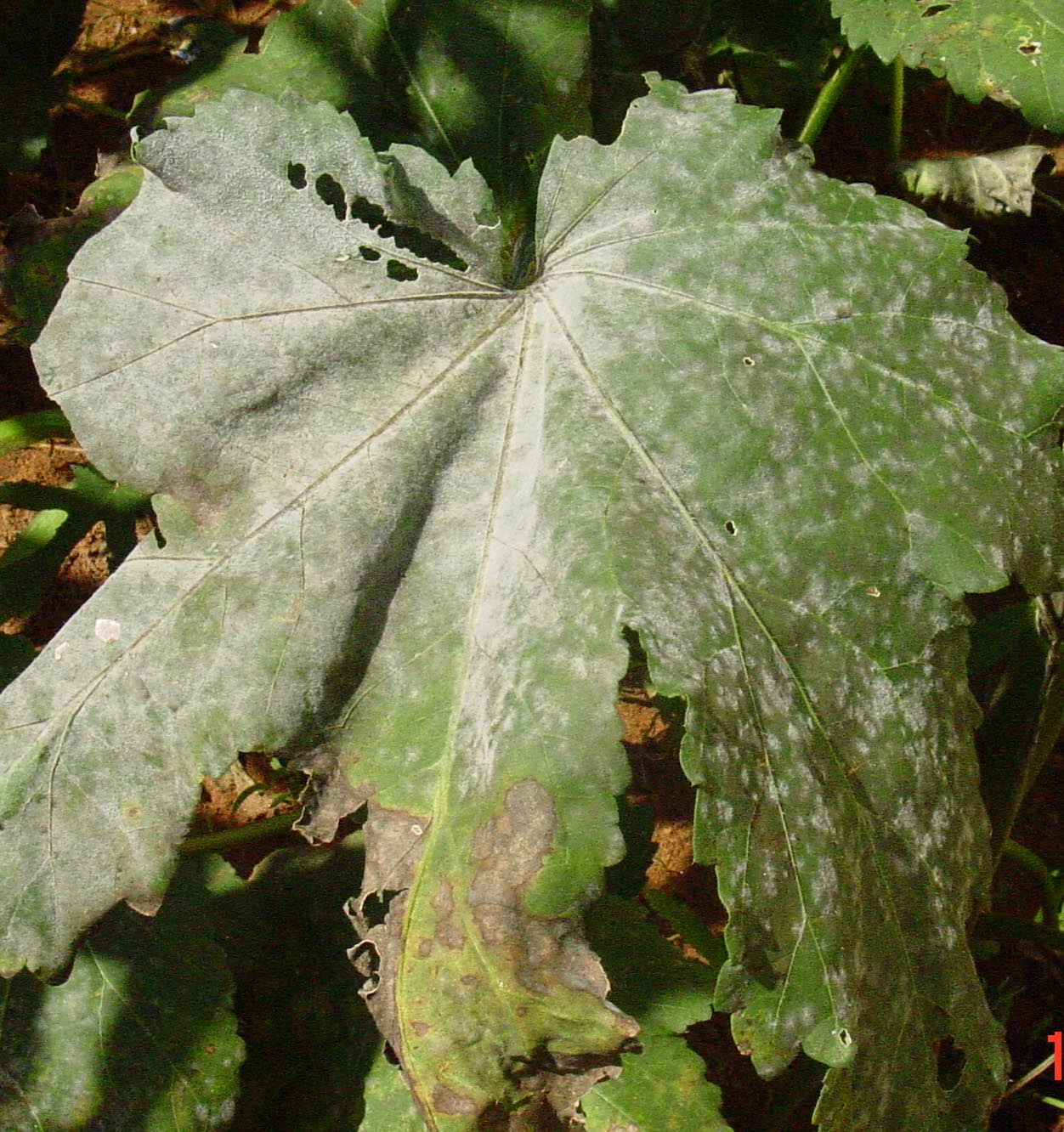
Control: Follow balanced manuring
and fertilizer application on the basis of standard recommendations. Application
of wettable sulphur (0.2%) or bavistin (0.1%) at one week interval effectively controls
the disease.
Cercospora leaf spot (Cercospora abelmoschi
and C. malayensis)
C. malayensis causes brown, irregular spots and C. abelmoschi
causes sooty black angular spots. The affected leaves roll, wilt and fall. The disease
causes severe defoliation during humid seasons.
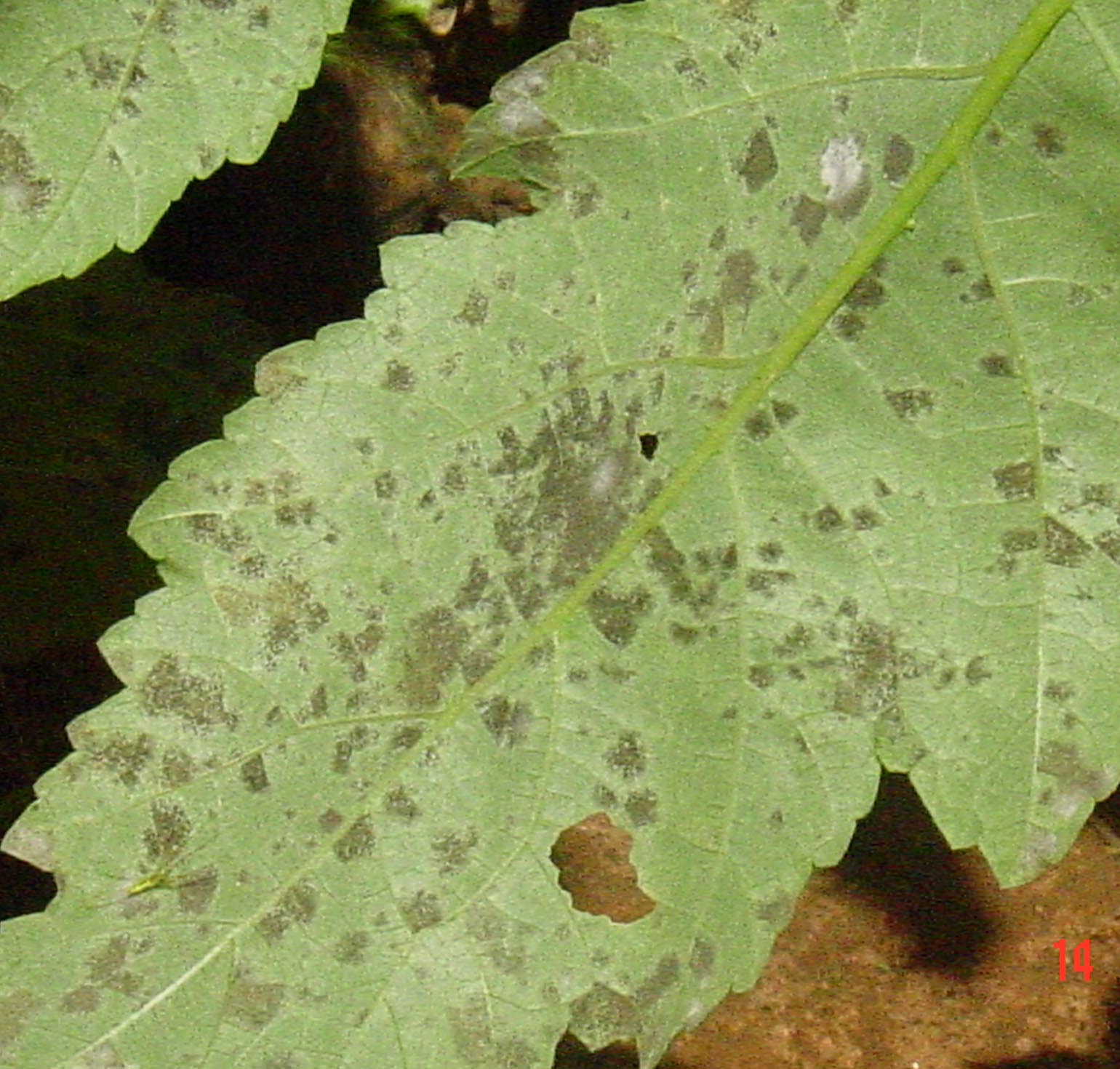
Control: Since the fungus survives
on the diseased plant material, removal and destruction of diseased plant material
helps to check the spread of the disease. The disease is effectively controlled
by spraying with copper oxychloride (0.3%) or zineb (0.2%) starting from about a
month after sowing and repeating at fortnightly intervals, depending upon the severity
of the disease incidence.
Enation leaf curl of bhindi
Symptoms appear on the lower surface of the leaf as small, pin-head enations, which
later on become warty and rough textured. Size of the leaf is reduced and become
thick and leathery. The most characteristic symptoms of the disease are twisting
of the main stem and lateral branches along with enations, giving the plant a creeping
appearance. Fruits produced are few and deformed. The natural transmission of the
disease is through whitefly
Control: Removal and destruction
of virus affected plants reduces the disease incidence. Controlling the whitefly
population minimizes the incidence of enation leaf curl also. Giving 4-5 foliar
sprays of dimethoate (0.05%) at an interval of 10 days effectively controls
the whitefly population.
Top
|